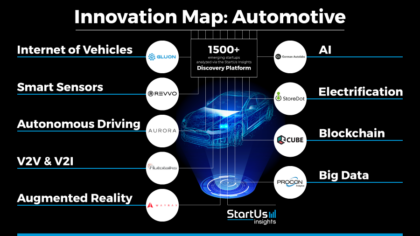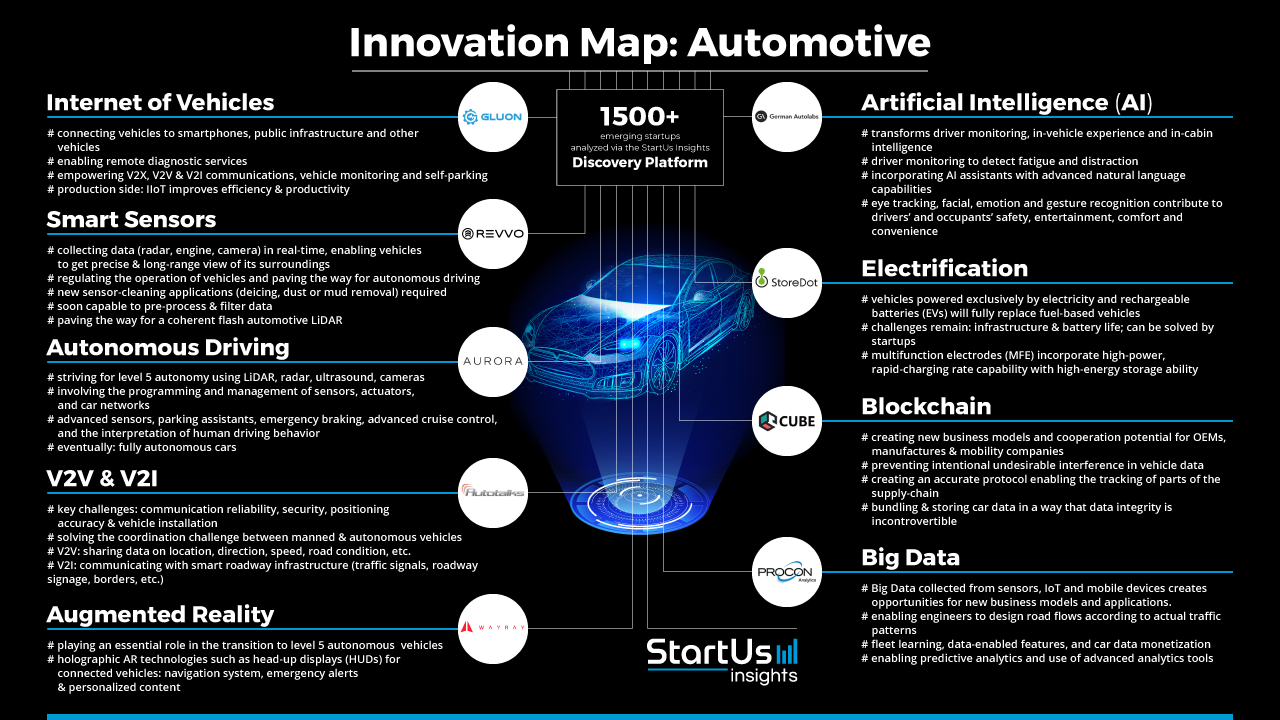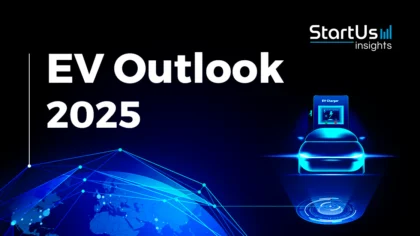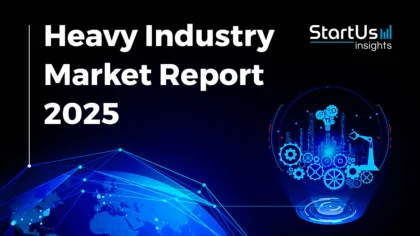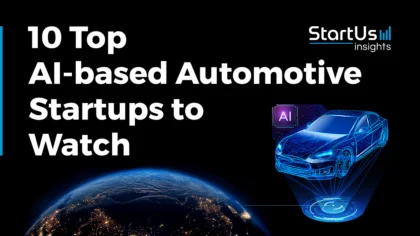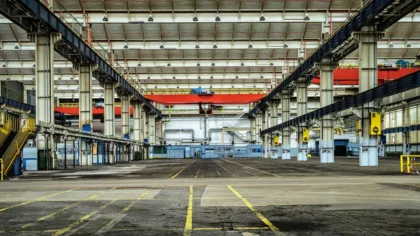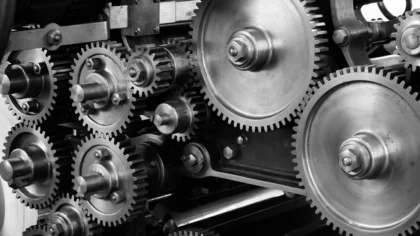Accelerate Productivity in 2025
Reignite Growth Despite the Global Slowdown
You already know that startups and their technologies are the driving forces behind some of the most recent changes in the automotive industry – think Tesla, for example. Industry leaders like Magna have already recognized this and are looking to collaborate with up-and-coming companies rather than compete with them. For one, strategic partnerships more often than not entail a win-win situation, and second, implementing new solutions in a fast and dynamic manner increases the impact of leading companies on the future of mobility.
This article was last updated in July 2024.
Dive into Our Data-driven Automotive Innovation Map
To provide you with actionable innovation intelligence and to showcase some of the 1.500+ startups our Innovation Experts at StartUs Insights have analyzed, we have clustered our findings in the Automotive Innovation Map. Let’s take a look at some of the major innovation areas for this industry:
Ready to explore all 1500+ Automotive Startups & Scaleups?
Internet of Vehicles
One of the most noticeable applications of the Internet of Things (IoT) in the automotive industry is the connected car, which powers functionalities like vehicle communications, vehicle monitoring, and self-parking among others. Equipped with internet access to various devices in- and outside the car, this new generation of vehicles is connected to smartphones, public infrastructure, other vehicles, and car manufacturers among others, making them one of the most important personal items of the future (for more see V2V and V2I).
In regards to maintenance services, the Internet of Vehicles allows for the monitoring of vehicles in real-time, offering the possibility of remote diagnostics and service alerts. Automotive companies can identify design, material, and structural problems related to a vehicle in real-time to make adaptations and alter these properties of a vehicle currently in production thereby improving efficiency and productivity.
Vehicle-to-Vehicle (V2V) & Vehicle-to-Infrastructure (V2I)
The underlying concept of V2V and V2I, Vehicle-to-Everything, or V2X, introduces a new era of intelligent transport systems (ITS), solving the coordination challenge between manned and autonomous vehicles while also increasing road safety and improving traffic management.
As V2V technology enables manufacturers to bring new functionalities to connected cars, it quickly gains in popularity. V2V enables vehicles to communicate with each other by sharing various data points including location, direction, speed, and road conditions via an ad-hoc network created by similarly connected vehicles. Vehicle-to-vehicle technology proactively avoids accidents, eases traffic congestion, and paves the way for advanced safety systems.
Vehicle-to-infrastructure, on the other hand, allows vehicles to communicate and exchange data with various types of smart roadway infrastructure in real-time including traffic signals, roadway signage, and border and rail grade crossings.
Autonomous Driving
Autonomous driving involves the programming and management of sensors, actuators, and car networks. To reach full autonomy a combination of various sensors including LiDAR, radar, ultrasound, and cameras are employed to sense the surroundings of a driverless vehicle. Though fully autonomous vehicles (Level 5) are not yet on our roads, autonomous technologies such as parking assistants, emergency braking, advanced cruise control, and the interpretation of human driving behavior are already shaping the future of transportation today.
Looking for specific Automotive Innovation Trends?
Smart Sensors
Incorporated into the new generation of vehicles, sensors are embedded into various objects and systems to collect data in real time. These data points are collected from radars, engines, cameras and more to regulate the operation of vehicles and enable autonomous driving. In the next years, these sensors will become more intelligent up to the point where they are capable of pre-processing and filtering data thus generating an immense impact on security, safety, and the cost of vehicle maintenance. However, a new grade of sensor-cleaning applications (deicing, dust or mud removal) is required to ensure the accurate operation of smart sensors in all conditions.
Artificial Intelligence (AI)
Even though artificial intelligence is an innovation area every one of us already encounters daily, it offers a vast variety of use cases in the future. In the automotive industry, artificial intelligence technologies allow for the monitoring of a driver’s emotions, gestures, and movements thereby detecting signs of fatigue or distraction and preventing accidents. While this feature is interesting to automotive companies, insurance providers will also benefit from it as it helps to identify risky drivers and assess damage claims appropriately. Moreover, AI-powered vehicles pave the way for the creation of digital identities thus recognizing drivers and granting access to a vehicle only to authorized people.
From a driver’s perspective, artificial intelligence is rapidly transforming the in-vehicle experience. In the next years, vehicles with incorporated AI assistants will respond to voice commands to proactively guide drivers in collaboration with the vehicle’s navigation system. Taking this concept one step further, the in-vehicle experience will go as far as to analyze calendars, frequently visited locations, and smartphone application data to deliver a highly personalized experience via onboard displays.
Big Data
One of the more common use cases for big data in the automotive industry is the application of advanced data analytics tools, equipping connected cars with the ability to effectively navigate. In addition, analyzing collected data points such as speed, direction, position, traffic signals, and pedestrian proximity enables a vehicle to easily make a decision and employ an appropriate response, further reducing the risk of human error. The next step big data will take in this industry is to enable predictive analytics thereby eliminating the risk of human error and having all the more impact on our driving behavior.
For engineers, big data plays an important role as it allows them to design road flows according to actual traffic patterns, resulting in safer roads while also contributing to developers’ progress in fleet learning, data-enabled features, and car data monetization.
Augmented Reality (AR)
Augmented reality plays an essential part in increasing the level of automation. On their way to level 5 autonomy, vehicles will slowly move from driver mode to automation mode. In between these levels (2-4), AR-powered technologies such as head-up displays (HUDs) are part of this transition. As an example, HUDs can present route information on the windshield of a vehicle, allowing drivers to keep their eyes on the road.
Blockchain
Generally considered to be a transformative technology, blockchain creates a trusted, accurate protocol that enables the tracking of vehicle parts of the automotive supply chain thus enabling car manufacturers, service centers, and customers alike to trace the origin of spare parts back to its original manufacturing location therefore significantly supporting the removal of counterfeit parts and shaping the pricing strategy of car manufacturers. Moreover, blockchain has the potential to create new business models and cooperation opportunities for OEMs, manufacturers, and mobility companies as it makes it possible to track down payments to single vehicles without involving third parties (e.g. banks).
Blockchain is also applicable in multi-party transactions and facilitates an immutable ledge. Because data that is validated and recorded on the blockchain cannot be altered, this technology will eventually prevent intentional undesirable interference in-vehicle data.
Electrification
Powered exclusively by electricity and rechargeable batteries, electric vehicles (EVs) gain significant momentum in the automotive industry as they shape the future towards fuel-efficient cars. High-capacity batteries that can be charged in a matter of minutes further advance EVs, eventually resulting in covering long distances on a single charge thus fully replacing fuel-based vehicles.
Despite this outlook on the future, current challenges such as infrastructure and battery life remain. Building a sustainable infrastructure in which EVs can be charged at any point and store energy for longer has become the main mission for some cutting-edge startups. Fastned, for example, develops and deploys electrical charging infrastructure and networks such as their “ultra-fast” 350 kW charging technology.
Disruptive Startups In The Automotive Industry Include:
- Gluon establishes an interconnected network of vehicles, offering diagnostics, monitoring, software performance tuning, fleet management, and blockchain payment solutions. The auto tech startup allows businesses to connect their vehicles with manufacturers, part suppliers, repair shops, and other service providers in their network via an app.
- Autotalks is a fabless semiconductor company specialized in V2V communications. The Israeli startup develops chipsets that link vehicles to each other as well as to the infrastructure thus enabling data sharing between all of them. Through their solution, Autotalks addresses core V2X challenges such as communication reliability, security, positioning accuracy, and vehicle installation.
- The autonomous car tech startup Aurora designs soft- and hardware for self-driving vehicles. Aurora offers the “full-stack” required to deploy level 4 autonomous systems – from sensor packages to software and data services – and already has its eye on level 5 autonomous systems.
- US startup Revvo develops a sensor-enabled AI software platform that continuously monitors vehicle tires. Its IoT sensors are embedded within the tires, wirelessly transmitting data to a cloud gateway. Leveraging machine learning, the platform analyzes sensor data alongside telematics and onboard vehicle system information. Further, Revvo’s software facilitates remote fleet management, aiding fleet managers proactively prevent tire-related incidents.
- German Autolabs develops Chris, a digital AI assistant for drivers with advanced natural language capabilities as well as gesture recognition technology. The startup’s automotive-grade platform offers an over-the-air (OTA) updateable digital assistance service for OEMs and Tier 1. This combination of an interoperable, scalable software platform for cognitive assistance with a retrofit hardware device aims at democratizing the latest connected car technology.
- Procon Analytics, a US startup, utilizes big data to provide an automotive finance solution. Its system collects real-time data from millions of data points and analyzes it, allowing lenders to evaluate and mitigate risk. This allows Buy Here Pay Here (BHPH) dealers to grow their operations and extend credit to high-risk clients. Further, Procon Analytics offers software solutions for fleet and asset tracking, along with connected cars
- WayRay develops holographic AR technologies for connected vehicles. With the Swiss startup’s augmented reality navigation system, drivers are enabled to see route-related information, emergency alerts, and personalized content information on their windshield.
- Cube Intelligence, a UK startup, creates a blockchain-powered security platform for autonomous and connected vehicles. Its technology employs hash codes to thwart malicious attacks and hacking incidents targeting self-driving cars. Further, Cube Intelligence’s hardware collects real-time mobility and emissions data. In addition to this, it provides ride-hailing and valet parking services for autonomous vehicles, along with smart parking management systems.
- Israeli startup StoreDot is working to advance the ecosystem for electric vehicles. Using a multifunction electrode (MFE), the startup’s fast-charging electric vehicle battery, FlashBattery, combines two benefits of energy storage solutions by incorporating high-power, rapid-charging rate capability with a high energy storage ability. The FlashBattery allows charging a vehicle within five minutes thereby preparing it for a roughly 480-km travel.
Explore Emerging Automotive Startups & Technologies
The global automotive industry is projected to reach USD 3969.84 billion by 2030, due to emerging startups and their technologies. To overcome key challenges such as complexity and cost pressure, diverging markets, digital demands, and a shifting industry landscape, leading automotive companies need to recognize that the technologies developed by young companies have the potential to alter the entire industry. Taking a closer look at these companies and understanding their technologies and vision to form strategic partnerships with them gives today’s industry leaders the edge they need to stay on top tomorrow.

